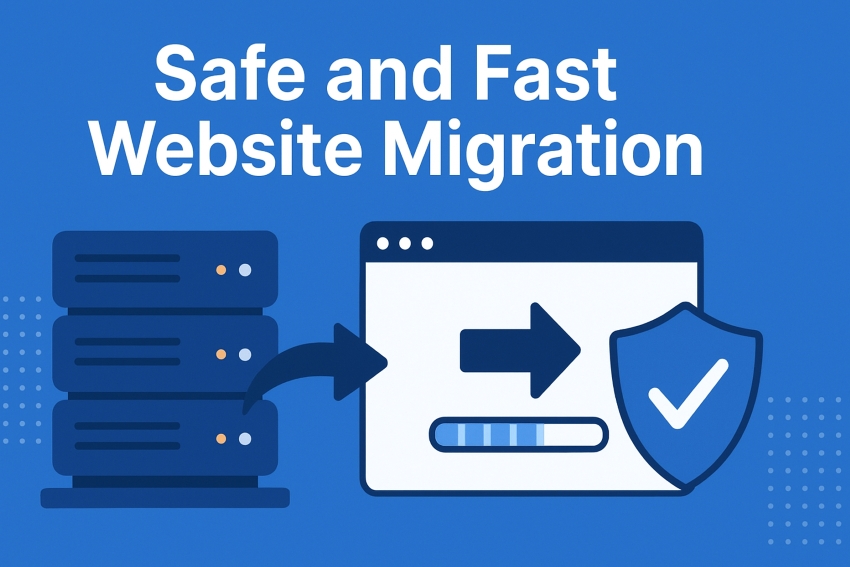Migrating a website is one of the most critical tasks in web management. Whether you’re switching to a better hosting provider or upgrading your CMS, a poorly executed migration can cause data loss, downtime, and SEO drops. That’s why Safe and Fast Website Migration is essential it ensures your website transitions smoothly without performance or ranking issues.
In this post, we’ll cover everything you need to know to migrate your site safely and efficiently.
What Is Website Migration?
Website migration refers to the process of moving your website from one hosting environment, platform, or domain to another. It involves transferring files, databases, email accounts, and DNS settings all while maintaining the site’s integrity and search engine visibility.
Common types of migrations include:
- Hosting provider changes
- Domain name updates
- Platform or CMS transfers (e.g., Blogger to WordPress)
- Design or structure updates
Why Safe and Fast Website Migration Matters
A slow or unsafe migration can cause:
- Data loss or corruption
- SEO ranking drops
- Broken links or missing images
- Long downtime, affecting traffic and credibility
A safe and fast migration prevents these risks by using tested tools, verified backups, and structured steps.
Pre-Migration Checklist
Before starting the migration process, make sure you:
- Backup your website files and database.
- Note down DNS and email settings.
- Check PHP versions, themes, and plugins compatibility.
- Inform your users or clients about possible short downtime.
- Create a staging site to test migration before going live.
Step-by-Step Process for Safe and Fast Website Migration
Step 1: Backup Everything
Use plugins like UpdraftPlus, Duplicator, or All-in-One WP Migration to create a complete backup of your WordPress files and database.
Step 2: Set Up the New Hosting Environment
Install WordPress or your chosen CMS on the new server. Make sure server settings and PHP versions are compatible with your site.
Step 3: Transfer Files and Database
You can transfer files via FTP or migration plugins. For databases, use phpMyAdmin to export and import MySQL files securely.
Step 4: Update DNS Settings
Point your domain to the new server by updating nameservers or A records. This may take up to 24 hours to propagate globally.
Step 5: Test the Migrated Website
Before going live, test:
- Page speed
- Links and images
- Contact forms
- SEO settings and URLs
Step 6: Monitor and Optimize
After migration, use Google Search Console and Analytics to track performance, fix broken links, and ensure SEO stability.
Best Tools for Website Migration
- UpdraftPlus – For automatic backups.
- All-in-One WP Migration – Simplifies full site transfers.
- Duplicator Pro – For complex WordPress sites.
- Cloudways Migrator – For fast cloud hosting transfers.
- WP Migrate DB – For database-only migrations.
Common Mistakes to Avoid
- Migrating during high-traffic hours.
- Forgetting to backup before migration.
- Ignoring broken internal links.
- Not checking plugin or theme compatibility.
- Failing to monitor SEO performance post-migration.
Benefits of Safe and Fast Website Migration
- Zero data loss
- Minimal downtime
- Improved site performance
- Better SEO continuity
- Peace of mind for users and admins
FAQ: Safe and Fast Website Migration
Q1: How long does website migration take?
Usually, a small website can be migrated in 1–2 hours, while larger ones may take up to 24 hours, depending on data and DNS propagation.
Q2: Does migration affect SEO?
If done properly with 301 redirects, consistent URLs, and no downtime migration won’t hurt your SEO.
Q3: Can I migrate my website manually?
Yes, if you’re comfortable with FTP and databases. Otherwise, use trusted migration plugins to simplify the process.
Q4: What should I do after migration?
Check your pages, images, and forms. Then, submit your new sitemap to Google Search Console.
Conclusion
A Safe and Fast Website Migration is about preparation, precision, and performance. By following the right steps, using reliable tools, and double checking configurations, you can transfer your website without downtime or SEO loss.
If you want expert assistance, consider Hiring a professional website migration service to ensure your data and SEO remain 100% secure.

